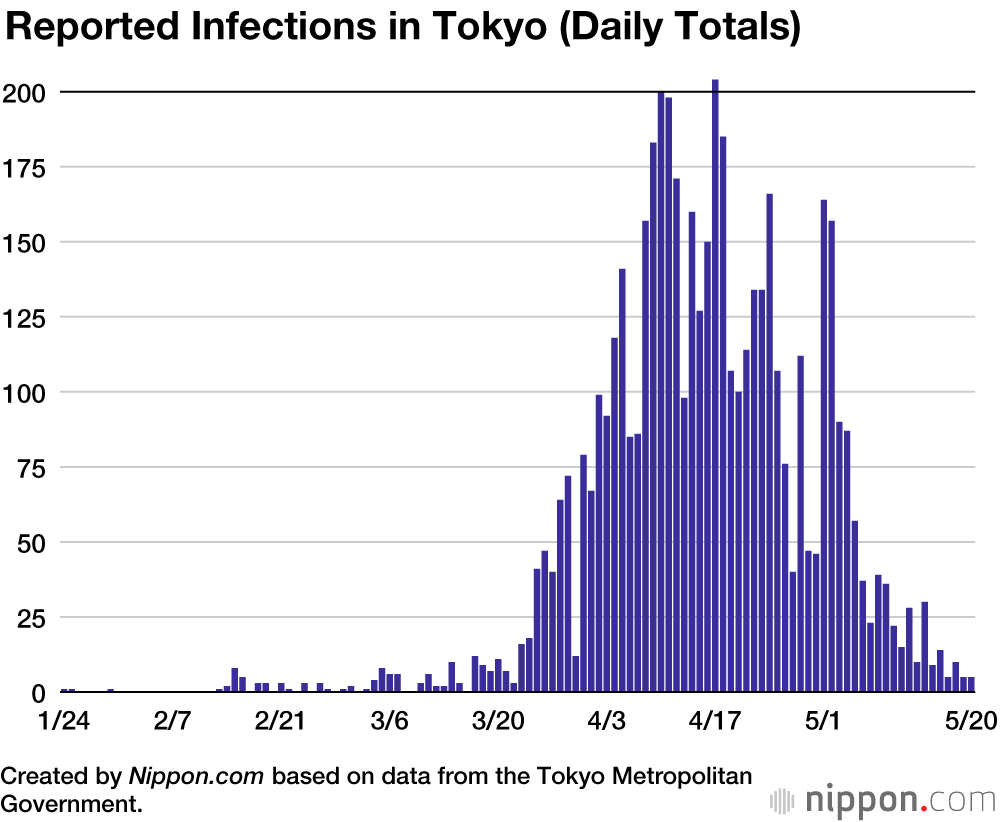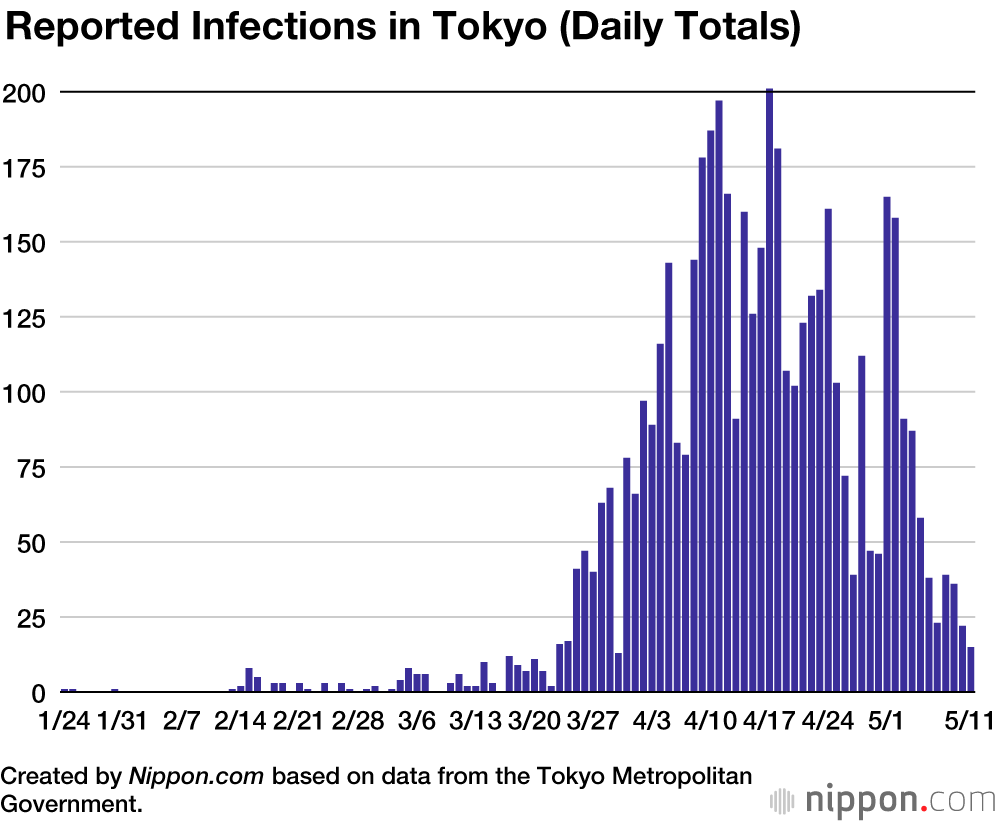
Coronavirus Cases in Japan by Prefecture (May 2020)
Society- English
- 日本語
- 简体字
- 繁體字
- Français
- Español
- العربية
- Русский
Click here for the latest updates.
Click here for updates from June.
May 31
Tokyo reports 5 new cases, dropping below 10 for the first time since May 26. Kitakyūshū in Fukuoka Prefecture reports 12 new cases, lifting its total to 97 over the past nine days.
May 30
Tokyo reports 14 new cases, meaning it now has 0.67 total cases per 100,000 people over the past week, rising above the 0.5 target previously set by the government for lifting the state of emergency.
May 29
Kitakyūshū in Fukuoka Prefecture reports 26 new cases. Mayor Kitahashi Kenji says the city is in the middle of a second wave.
Tokyo Governor Koike Yuriko says that the metropolis will move to the second of its three-stage roadmap for reopening the economy on June 1. Business suspension requests will be relaxed for cram schools, movie theaters, commercial facilities, and sports gyms, on the understanding that they will take thorough measures to prevent infection. At a press conference, Koike stresses that it will be a long fight to contain the coronavirus.
Tokyo reports 22 new cases, the first time the total has risen above 20 since May 14. It has reported new cases in double figures for the past four days.
May 28
Kitakyūshū in Fukuoka Prefecture has now reported 43 new cases over the previous six days. Fukuoka has 0.88 total cases per 100,000 people over the past week, rising above the 0.5 target previously set by the government for lifting the state of emergency. Hokkaidō, which did not meet this target at the time its state of emergency was lifted, has seen its figure rise further to 1.03.
May 27
The city of Kitakyūshū in Fukuoka Prefecture warns of a second wave of infections after reporting a total of 22 new cases over the previous five days. It closes some public and tourist facilities until June 18, having removed restrictions after the state of emergency was lifted.
May 25
The government lifts the COVID-19 state of emergency in the five remaining prefectures of Hokkaidō, Tokyo, Kanagawa, Saitama, and Chiba. It is one and a half months since the initial state of emergency was declared on April 7. There is no immediate return to everyday life, though, as restrictions will be eased in stages.
In the five prefectures where the state of emergency is lifted, Tokyo reports 8 new cases, Hokkaidō 2, and Kanagawa and Saitama 1 each.
May 23
Tokyo reports 2 new cases, bringing its total to 5,138. In the other prefectures still under a state of emergency, Kanagawa reports 5 cases, Saitama 1, Chiba 0, and Hokkaidō 9. Minister for Economic Revitalization Nishimura says at a press conference that a positive trend is continuing.
May 22
Tokyo reports 3 new cases, bringing its total to 5,136. It is the lowest daily total since the state of emergency began on April 7.
The Tokyo Metropolitan Government releases a three-stage roadmap toward the reopening of businesses. In the first stage, it will allow libraries and museums to reopen and restaurants and bars to stay open two hours later, until 10:00 at night. If the government lifts the state of emergency on May 25, the first stage would come into effect the following day. In the second stage, shopping malls, theaters, movie theaters, and cram schools will be allowed to reopen, while the third stage will let amusement parks and pachinko parlors reopen and permit restaurants and bars to operate until midnight.
May 21
The government lifts the state of emergency in Osaka, Kyoto, and Hyōgo Prefectures. It will make a further decision on May 25 about lifting it in the remaining prefectures of Tokyo, Saitama, Chiba, Kanagawa, and Hokkaidō. With 59 cases over the past seven days, Tokyo has achieved the target of 70 or below for the first time.
Tokyo announces that 58 cases were unreported, 6 were reported twice, and 5 negative cases were wrongly reported as positive. This adds 47 to its cumulative total. With the 11 new cases for the day, Tokyo’s overall figure rises to 5,133.
May 20
The Japan High School Baseball Federation announces the cancellation of the summer high school baseball tournament for the first time in the postwar era.
Tokyo reports 5 new cases, bringing its overall total to 5,075. It has had 78 new cases over the past week.
May 19
Tokyo reports 5 new cases, equaling its lowest daily total since the announcement of the state of emergency and marking two weeks in which there have been fewer than 50 new daily cases in the metropolis. However, to meet the government target for lifting the state of emergency of 0.5 or fewer total cases per 100,000 people over the past week, Tokyo—with a population of 14 million—still needs to reduce its cases to 70 in one week.
Osaka Prefecture reports 3 new cases, while there are zero in neighboring Kyoto and Hyōgo. These three Kansai prefectures are meeting the government target ahead of a decision to be made on May 21 about lifting the state of emergency in the remaining eight prefectures.
May 15
Apparel maker Renown announces that it has gone bankrupt with debts of ¥13.8 billion. Temporary closures of department stores and shopping malls brought a slump in sales. It is the first listed company in Japan to go bankrupt due to the COVID-19 pandemic.
Tokyo reports 9 new cases, bringing its total to 5,036. This is the tenth successive day that there have been fewer than 50 cases and the first time since March 22 that the total has been less than 10.
May 14
Prime Minister Abe Shinzō orders the government to compile a second fiscal 2020 supplementary budget. The first ¥25.7 trillion supplementary budget enacted on April 30 included ¥100,000 payments to all residents and payments of up to ¥2 million for small and medium-sized businesses that suffered major drops in sales. Among its provisions, the second budget will almost double the daily maximum subsidy for companies to retain employees while their business is suspended to ¥15,000.
Prime Minister Abe lifts the state of emergency in 39 prefectures. They include Ibaraki, Ishikawa, Gifu, Aichi, and Fukuoka, which had been among 13 prefectures designated for stepped-up measures. The state of emergency will continue in Hokkaidō, Chiba, Saitama, Tokyo, Kanagawa, Kyoto, Osaka, and Hyōgo, with a decision to be made later on a possible early end on May 21.
May 13
The Japan Sumō Association announces that 28-year-old rikishi Shōbushi has died of multiple organ failure due to pneumonia caused by COVID-19. He was hospitalized on April 8 and tested positive for the virus at another hospital on April 12. This is the first fatality reported in Japan for someone under 30.
May 12
Toyota announces that it expects its operating profit to fall by 79.5% year on year to ¥500 billion in the fiscal year ending March 2021. The pandemic has brought major economic disruption around the world and production and sales are projected to plummet. The company projects it will sell 8.9 million vehicles, which would be the first drop below 10 million units in eight years.
Tokyo reports 28 new cases, meaning that it has now had a week with fewer than 50 new cases reported each day.
May 11
Tokyo Governor Koike says that the metropolitan government has found 111 unreported cases and 35 that were reported twice. It will later add 76 cases to its total.
Tokyo reports 15 new cases. This is the first time the daily figure has dropped below 20 since March 30.
May 10
Minister for Economic Revitalization Nishimura says that the state of emergency may be lifted in the 34 prefectures that have not been designated for stepped-up measures, as well as Ibaraki and Gifu.
May 9
Tokyo reports 39 new cases, meaning that the daily number of new cases has been below 100 for a week. Reduced testing during national holidays played a part in the earlier part of this period, but the lower numbers have continued even after the end of the holidays. A man in his eighties dies in Miyagi Prefecture, marking the first fatality in Tōhoku. The area has had relatively fewer cases than the rest of the country, and includes Iwate, the only prefecture to have reported zero cases.
A case reported on Mikurajima is the first on any of a number of Japan’s outlying islands that are administered by the prefecture of Tokyo. Mikurajima is 200 kilometers south of the capital.
May 8
Tokyo reports 39 new cases, marking the sixth consecutive day that the number of cases has been below 100. While the closure of some medical institutions during much of this period has played a part, business closures and efforts to reduce trips outside seem to be starting to show their effects.
May 7
There are 96 new nationwide cases (including those in airport screening), as the figure drops below 100 for the first time in over a month. The 23 new cases in Tokyo amount to the capital’s lowest daily total since the declaration of a state of emergency. However, these figures are influenced by coming after a national holiday when some medical institutions were not open.
The Ministry of Health, Labor, and Welfare approves the antivirus drug remdesivir, using fast-track screening procedures. The drug was developed by US company Gilead Sciences for treatment of Ebola, but has shown some effectiveness in treating COVID-19. It is due to go into use from this month.
May 4
Tokyo reports 87 new cases, bringing its total to 4,654. Hokkaidō reports 31 new cases for the day, with 29 of them in Sapporo, registering a new daily high for the prefectural capital. The government decides to extend to May 31 the nationwide state of emergency that had been due to expire on May 6.
May 2
Tokyo reports 160 new cases, reaching a total of 4,477. The number of nationwide fatalities (excluding cruise ship passengers) reaches 500, and Tokyo is the prefecture with the most deaths at 141, followed by Osaka with 46, Hokkaidō with 40, and Kanagawa with 38. Tokyo’s highest daily total of 15 deaths came on May 1.
May 1
Tokyo reports another 165 cases, bringing its total to 4,317. This follows two days in which there were fewer than 50 new cases. Prime Minister Abe states plans to extend the nationwide state of emergency for around a month, with the announcement to be made by May 6.
Click here for updates from April.
(Translated from Japanese. Banner photo © Pakutaso.)


